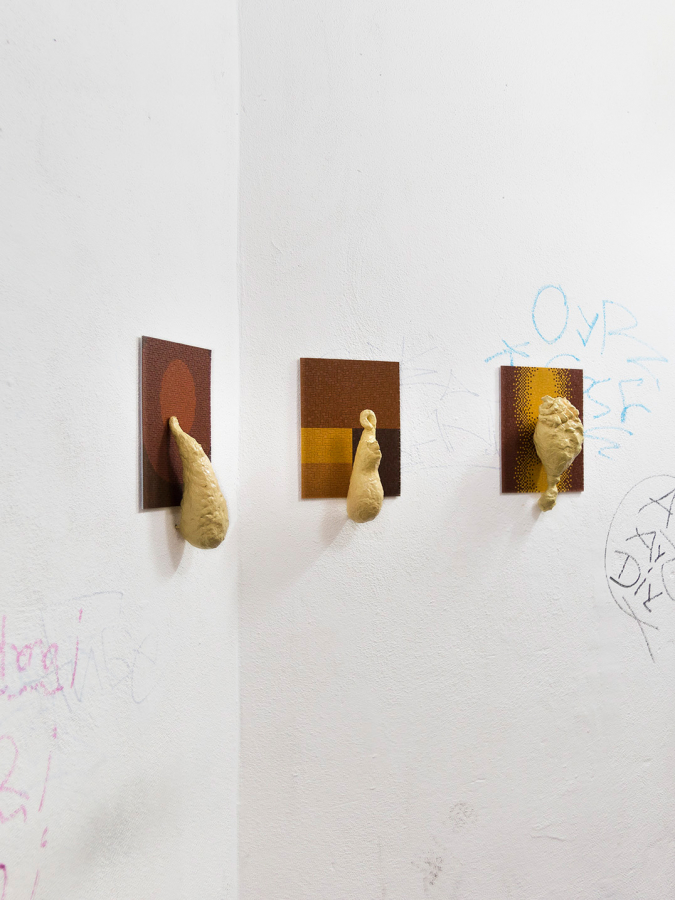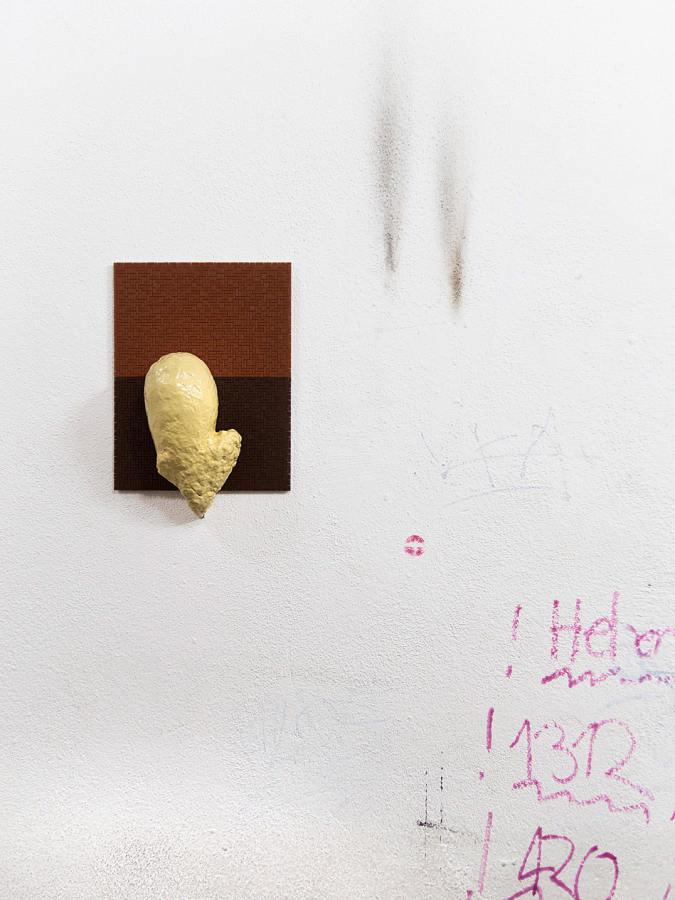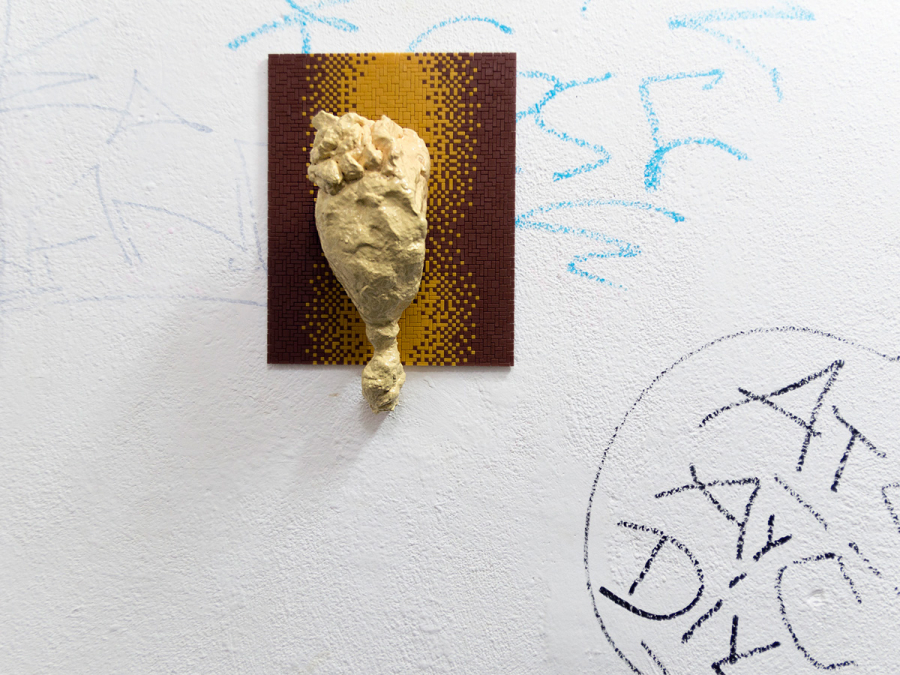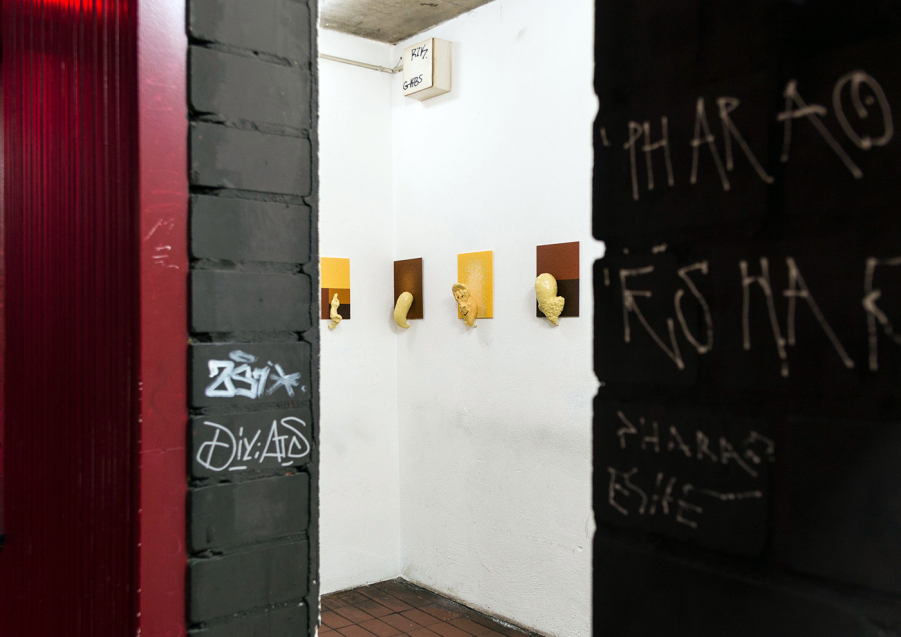







Norbert Bayer & Björn Streeck
«I can’t believe it’s not»
Golden Pudel Club Hamburg
Ministeck, Pappmache, Acryl, Stahl
Bild 33,3 x 26,6 cm
Objekt div. Maße
Berlin, 2019
B: «Wir brauchen keine anderen Welten! Denn jeder Montagepunkt kann aus seiner gewohnten Position in eine andere Position verschoben werden. Sobald ein Montagepunkt sich verschiebt, ermöglicht er die Wahrnehmung einer ganz anderen Welt, die ebenso faktisch und objektiv ist wie die Welt, die wir normalerweise wahrnehmen.»
N: «Stimmt, mit anderen Welten wissen wir nichts anzufangen. Es genügt unsere eine, und schon ersticken wir an ihr. Wir wollen das eigene idealisierte Bild finden; andere Welten haben deshalb vollkommener zu sein als die unsere. Oder wir hoffen in ihnen das Abbild unserer primitiven Vergangenheit zu finden.»
B: «Wir brauchen Spiegel! Die Wand, das kann stets einen muroir bilden.»
N: «Geschmäcker und Traditionen ändern sich ...»
B: «Aus Sicht der Archäologen sind diese Objekte deshalb so erstaunlich, weil sie für ein weitflächiges Kommunikationssystem stehen. Sie wirken wie von allem übrigen abgetrennte Prozesse, irgendwelche in sich geschlossene, unterdrückte, zugemauerte Entzündungsherde im Gedächtnis. Sie wurden als Anleitung behandelt, als Konstruktionsplan. Du weißt ja, wie ähnlich einander diese asymmetrischen Kristalle sind, die der Chromosomen und die jener Nukleinverbindungen der Cerebroside, die das Substrat der Merkprozesse bilden.»
N: «Getrieben von Genussfreude sind die Künstler zu Werke gegangen. Fleisch ist ihr Hauptinhalt. Menschenfleisch und Tierfleisch. Dabei ging man von einer einheitlichen religiösen Vorstellung aus.»
B: «Und das Wort wird Fleisch ...»
N: «Selbst diejenigen, die ewigen Seligkeiten versprechen, können das nur tun, indem sie unterstellen, dass der Körper sich dorthin begibt. Glorreich oder nicht, er muss dort sein. Es braucht einen Körper.»
B: «Das war alles aus dieser einen Substanz, die schon völlig steif war, wie gelblicher Gips. Das war nur so die allgemeine Form, so etwas ein Modell, aber wohl in natürlicher Größe. Nach einer Weile begann alles zu springen und zu zerbrechen; durch die Ritzen, die ganz schwarz waren, quetschte sich dicker Schleim wellenweise an die Oberfläche hervor und erstarrte, teils rann er ab, teils blieb er, und alles begann immer energischer durcheinander zu stürzen und bedeckte sich mit Schaum, und außer Schaum sah ich nichts mehr.»
N: «Eine dieser unansehnlichen Dellen hat der Künstler so geschickt hingedreht, dass sie zum Bauchnabel wurde – eine geniale Leistung!»
B: «Längst nicht alles wurde aufreizend und naturalistisch dargestellt. Viele sind geradezu abstrakt im Stil. Die Unmöglichkeit, zurückzukehren zum Abstrakten, ist bedingt durch unsere Weigerung, die Tatsache zu akzeptieren, dass wir ohne Worte und sogar ohne Gedanken etwas wissen könnten.»
N: «Was geschah da?»
B: «Es ist absolut unglaublich, dass wir nicht die geringste Art Idee davon haben.»
N: «Die Lust, worin besteht sie?»
B: «In der antiken Moral ist die Lust, die gerade darin besteht, daraus so wenig wie möglich zu machen, eine Askese. Was genießt man, wenn nicht, dass sich eine Spannung produziert? Das ist das eigentliche Prinzip von allem, was den Namen Genießen hat.»
N: «Wo kommt es unter, das Genießen? Was braucht es dafür?»
B: «Körper. Der Mann spielte dabei keine Rolle. Es war, als würde man von einem mächtigen Vater und einem noch mächtigeren Großvater erzogen, die sich niemals von Angesicht zu Angesicht begegnen. Bei solch einem Wettkampf gewinnt immer der Großvater. Eine Wiederholung kann evidenterweise erst mit dem zweiten Mal beginnen, das sich somit als das erweist, welches die Wiederholung einführt. Das ist die Geschichte der Null und der Eins. Nur mit der Eins kann es keine Wiederholung geben, so dass es, damit es Wiederholung gibt, ein Drittes geben muss.»
N: «Es gibt schließlich Leute, für welche die Begegnung mit der Wahrheit vielleicht eine Rolle spielt, die die Griechen einer Metapher entlehnten – es hat denselben Effekt wie die Begegnung mit dem Zitterrochen, es betäubt sie.»
B: «Sind es Traumbilder einer von Krisen geschüttelten Welt? Die Unwissenheit ist an das Wissen gebunden. Sie ist eine Weise das Wissen zu etablieren, daraus ein etabliertes Wissen zu machen. Und dann gibt es gewisse Formen von Institutionalisierung – man geht in einem mimischen Theater auf.»
N: «Aber genau dazu dient diese, die Metapher, nämlich einen Sinn hervortreten zu lassen, der über die Mittel dazu um vieles hinausgeht. Der Zitterrochen, und dann derjenige, der ihn berührt und der darüber in Starre verfällt – es ist offensichtlich die Begegnung zweier untereinander nicht abgestimmter Felder.»
N: «Wen hätten sie erregen sollen? Wer weiß etwas in der Welt?»
B: «Das sind die ätherischen Sphären. Sie wissen. Und es wird Zeit brauchen damit das vorübergeht. Genau darin ist das Wissen von Anfang an mit der Idee der Macht verknüpft.»
N: «Es könnten Werke des Untergangs sein.»
B: «Warum?»
N: «Weil die Dimension des Genießens für den Körper die Dimension des Abstiegs zum Tod ist.»
B: «Im Übrigen bemühen wir uns, dass zu diesem Sinn der Zugang nicht allzu leicht sei, so dass Sie das Ihre dazu tun müssen, was eine gesundheitsfördernde und sogar therapeutische Absonderung ist. Sondern Sie den Sinn kraftvoll ab, und Sie werden sehen, wie sehr das Leben leichter wird.»
Out of the blue: The foam of bright nights
A one evening installation by Norbert Bayer and Björn Streeck
at the «Golden Pudel Club» in Hamburg St. Pauli
by Ursula Panhans-Bühler
Title or remark: «I can’t believe it’s not» … a what? – simply said: an installation of 12 mixed media works, not cheaper in dozens but richer in its metamorphic qualities. The flat Ministeck background images look like noble colour field paintings with a sophisticated combination of light ochre, brown and reddish dark brown hues, arranged in few geometric partitions, or composed with a darker hue slightly changing to a kind of brighter halo in the centre. The clumsy sculptures were shaped from paper pulp, coated with a thick resin shimmering in bright Beige. Like ectoplasmic emanations they shimmer between different metamorphic impressions. Is this one a mini bunny, and that one a childish Bozzetto of the lower back of Donatello’s David? This one, a recently excavated fragment of a tiny old-time idol, now backward highlighted by a Ministeck halo, and that one a dreamy head looking like too long neglected as mere mud dough? Another one seems to try a way-out as Klein bottle closed onto itself, while a stocking cap seems to disguise a fatso face, coming out of a Ministeck ring of sombre brown halos. An apparently gorgeous misfit heart is pushing one bulging ail out of a furry base, and a hearty stuffed sausage seems to wait on a passage to a honourable ghost, and so on in a protean power of creation.
All in all, like classical grotesques, who played with a double sense by their inventions, the tiny sculptures call up ambiguous memories of observers, while avoiding any strict iconographic meaning. Balancing on the verge of form and anti-form, they operate on the provocative line of impure sculptures, where you feel the literally handling of the material by a wide range of artists, as for instance De Kooning’s «in statu nascendi» sculptures, Paul McCarthy’s embarrassing clumped collage sculptures, or Antony Gormley’s myriads of small clay figures out-of-the-hand of nameless collaborators sharing the light. All avoid clear-cut, smooth formed surfaces of classic elegance. But while most sculptor artists work with a clear difference between amorphous and poignant subjects, the artists of «I can’t believe it’s not» disguise the origin of the matter of fact within the trompe l’oeil of a sublimating transformation. Unlike the phantasmal sources of hallucinated ectoplasm, repressing any other material source of its imaginary, the two artists open up with their works a turn into another creative process of «You may believe it’s not a …».
But let’s highlight the clever cooperation of the two artists for this project. How near can you bring together flatness and deepness, surface and volume, or the abstract and the corporeal, the opposition of Magritte and Mondrian, so to speak? First answer could be: it must not be glued to a unity. A method of Norbert Bayer’s and Björn Streeck’s cooperation to bring the opposed media together is given by the delicate handling of the colours. While all sculptures have the same bright beige coating, the Ministeck paintings include the hue of the sculptures in its chromatic range also. Sometimes it’s just the same bright creamy monochrome colour, sometimes the chromatic cadence elaborates a swinging harmony out of the colours’ changing optical sound. The second smart decision was to elaborate the Ministeck pictures not as a mere backdrop for the sculptures, but to create a dynamic interplay between these flat screens when being half elevated, and the sculptures thus only half overlapping them. The result is a situation of opposing forces, protruding or intruding forms, and echo-like reverberations of a calm geometric strength. The elegant interplay of the colours supports the unfolding pas de deux of changing constellations in every piece and the careful arrangement of the sequence as a whole.
However, there is one exception in the relation of the two elements. One object is isolated. Positioned right under its Ministeck counterpart, its creamy surface is echoed in the lower part of the flat surface, but also in the adjacent fully cream coloured object constellation. The isolated figure’s upright position is underlined by the vertical partition in the Ministeck field above her. The tiny figure provokes a memory of the famous figurine called «Venus of Willendorf», the rudimentary legs of the original sculpture melted into a kind of mermaid tail. Yet her enormous swelling tits and belly are flattened down, their outlook now reminding some Brancusi inventions. Seemingly, the still humid paper pulp was pressed on a surface to reach this flat appearance. Looking back to Brancusi’s sculpture «The Kiss», you can remark a flat surface hidden just in between the two lovers, like an ultimate border, unless you fix yourself on the crude unity of the marble block.
Let’s take it up with a risky twist. In an established geometry, it’s easy to pass back and forth from the 3rd dimension to the 2nd and the 1st one. But in life, performing a passage seems somehow more complicated. The passage from 3rd to 2nd involves the drama to cut the line of infinity through a continuity to establish that basic distance of any image as an «in-between», an interface. And all of a sudden, there is another relationship, a discreet and secretive one, balancing between the flat surface of the Ministeck and that of the rough sculpted object. «You can’t believe it’s not?» Obvious associations might miss the point; you might find the poodle’s core in the marvellous metamorphic passage into art, figured out by the ingenious work of the two artists, giving an optimistic farewell to any sad object art.
Ursula Panhans-Bühler
Hamburg, September 2019